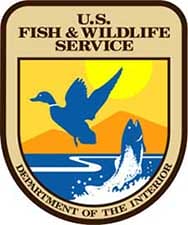
USA – -(AmmoLand.com)- The Department of the Interior announced today that it has once again made substantial progress in Fiscal Year 2020 to reduce the risk of wildfire nationwide by treating a ten-year best 1.5 million acres of public lands.
In continued efforts to reduce wildfire risk across much of the United States, the U.S. Fish and Wildlife Service (Service) has exceeded yearly milestones to ensure National Wildlife Refuge System lands remain healthy, resilient, and accessible to the public. The Service completed a significant amount of fuels treatments in FY2020 to reduce hazardous fuel loads, provide wildfire suppression efforts across the country, and increase protection of local communities surrounding fire-prone areas.
“President Trump set aggressive targets to more effectively and actively manage our rangelands and forests to prevent catastrophic wildfires. He took bold action on this issue, which had been missing in previous administrations,” said U.S. Secretary of the Interior David L. Bernhardt.
“Answering the call in hitting our significant milestones were our top-class wildland firefighter crews, who have been on the front lines working around the clock to conduct these preventative treatments and extinguish destructive blazes throughout the West this year. They deserve our unending appreciation.”
“The Trump Administration has successfully delivered on mitigating risk from wildfire through implementing active management,” said Service Director Aurelia Skipwith. “Under Secretary Bernhardt’s leadership, the Service’s women and men work to protect our nation’s refuges and local communities from wildfire risk by taking the necessary steps to manage habitat and reduce hazardous fuels to prevent major wildfires.”
Of the more than 1.5 million acres treated by Interior, the Service’s Fuels Management Program in FY2020 successfully completed more than 590 individual fuels treatments that directly and positively impacted 356,630 acres of Refuge System-managed lands. Of these hazardous fuels treatments, 84 percent occurred within the wildland-urban interface, better protecting communities and infrastructure from unwanted wildfire. During the Trump Administration (2017-2020), the Service has conducted 2,508 hazardous fuels treatments on more than 783,900 acres of Service lands – helping to conserve, protect and enhance fish, wildlife, plants and their habitat.
With more than 75 million burnable acres where 80 percent of this land has evolved with fire, the Service’s fire program is responsible for protecting more land management units than any other federal agency. The Service committed over 251,000 hours of personnel time-fighting wildfires and 64,000 hours of personnel time responding to all-hazard incidents in FY2020.
These efforts support President Trump’s overall goals outlined in Executive Order 13855 – Promoting Active Management of America’s Forests, Rangelands, and Other Federal Lands to Improve Conditions and Reduce Wildfire Risk, as well as the Secretary of the Interior’s Order 3372 – Reducing Wildfire Risks on Department of the Interior Land through Active Management, by better protecting people, communities, wildlife habitat and watersheds by actively managing habitat to reduce the risk of wildfire. Total reported fuels treatments include wildfire acres that were determined to meet management objectives. These totals are not included under the goals of the Executive Order, as they are the result of unplanned wildfire events.
Since the beginning of FY2020, Service lands experienced 339 wildfires that either started on or burned onto Service lands totaling 169,469 acres burned. So far this year, 76 wildfires have interacted with the agency’s fuels treatments, successfully slowing the spread of wildfire. Without fuels treatments in these fire-prone areas, wildfires have the potential to impact local communities, sensitive ecosystems and wildlife populations.
After a wildfire, the Service works quickly to stabilize, restore and enhance burned areas and protect waters, roads and communities from erosion and sedimentation. Thus far in 2020, the Service has seeded more than 150 acres to stabilize soil and prevent erosion. Through burned area rehabilitation, a long-term action to repair wildfire-caused damages, Service crews have started strategic restoration on 895 acres.
Partnerships are an important component of the Service’s fire-management program. This year, through prescribed fire or mechanical forest fuel reduction, the Service provided mission support to nine U.S. Air Force installations across the country to reduce the potential for lost training days, damaged infrastructure and important habitat restoration and enhancement. This partnership supports not only our nation’s military readiness but also furthers our conservation mission on military lands.
In the early months of 2020, Australia requested firefighter assistance in fighting unprecedented bushfires across the country. The Service provided 11 individuals to assist in suppression efforts over four months. Service personnel filled important roles including overhead positions and on-the-ground firefighters.
For more information on the fire management at the Service, visit www.fws.gov/fire/.
For more on the Department of the Interior’s Office of Wildlife Fire and coordinated efforts across the Department of the Interior bureaus to manage and control wildfires, visit www.doi.gov/wildlandfire.
The mission of the U.S. Fish and Wildlife Service is working with others to conserve, protect, and enhance fish, wildlife, plants, and their habitats for the continuing benefit of the American people. We are both a leader and trusted partner in fish and wildlife conservation, known for our scientific excellence, stewardship of lands and natural resources, dedicated professionals, and commitment to public service. For more information on our work and the people who make it happen, visit www.fws.gov.
For more information on our work and the people who make it happen, visit www.fws.gov/. Connect with our Facebook page, follow our tweets, watch our YouTube Channel and download photos from our Flickr page.

